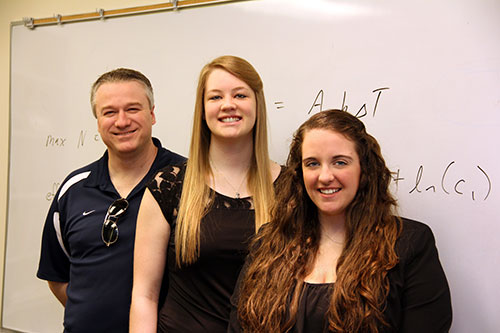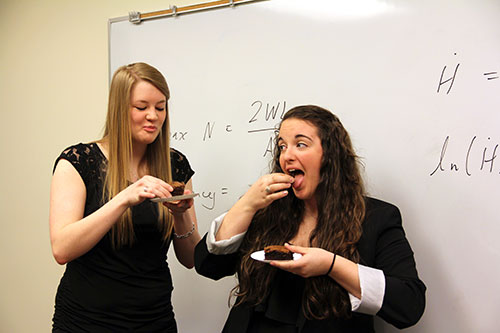Students Enjoy "Sweet" Finish in Math Competition

Steven Broad, assistant professor of mathematics, is pictured
with Olivia McIntee '13 and Samantha Brady '13 who were
among the Meritorious Winners in an international math
competition. Their challenge was to determine what size pan
would produce brownies without burnt edges.Contact:
Gwen O’Brien
Director of Media Relations
Saint Mary's College
Notre Dame, Ind.
(574) 284-4579
April 23, 2013 (Notre Dame, Ind.)—Saint Mary’s College is proud to announce that a team of mathematics students finished in the top 15 percent of the nearly 7,000 teams that competed in the Consortium for Mathematics and Its Applications (COMAP) international competition called Mathematical Contest in Modeling (MCM). Samantha Brady ’13 of South Bend and Olivia McIntee ’13 of Sylvania, Ohio made up the team that was named among the Meritorious Winners. They solved the eternal question: How can you produce brownies without burnt edges? Their solution: a hexagonal pan.
It is the fourth time a Saint Mary’s team has had a Meritorious finish in the decades the College has competed. It is the first time Saint Mary’s fielded more than two teams, with three competing this year. The other two teams received Successful Participant ratings. One of those teams included Jessica Kinnick ’13 of Youngstown, Ohio and Margaret Brown ’13 of Corpus Christi, Tex. and the other team was made up of Brianne Michaels ’14 of Valparaiso, Gina Deom ’13 of Evansville, and Brigid Lally ’13 of Cleveland.
“I am very proud of all of them,” said Steven Broad, assistant professor of mathematics. “They all presented interesting solutions with plenty of technical merit.”

Olivia McIntee '13, left, and Samantha Brown '13 enjoy a brownie and
a laugh. Their math problem was to figure out the ideal shape of a
brownie pan so the edges aren't burnt. Their answer: a hexagonal pan!Broad said the mathematics department learned of the outcome of the February competition last week. It took weeks for the contest organizers to pore through the 20+ page reports submitted by each of the 6,747 teams and determine the winners. The competition took place over a four-day weekend. No travel is required as students from around the world compete remotely.
“During this four-day process students eat, sleep and breathe the competition, producing papers with highly technical responses to the problems,” explained Broad. “Once the competition starts, faculty aren't allowed to help. The students are left to use their best judgment about what works and what doesn't.”
The contest involves solving an open-ended problem. Teams had a choice between two math problems. One problem, in part, was to determine what the ultimate shape of a brownie pan would be so heat is evenly distributed and the corners of the brownies are not overcooked or burnt. The other problem was to build a mathematical model for an effective, feasible, and cost-efficient fresh water strategy to meet the projected needs of one of the world’s largest and/or driest countries.
 Brady, who is earning degrees in statistics and actuarial mathematics and management information systems, and McIntee, a dual degree student studying mathematics (at Saint Mary’s) and mechanical engineering (at the University of Notre Dame), chose the brownie problem. They determined that a hexagon would produce the highest quality brownies.
Brady, who is earning degrees in statistics and actuarial mathematics and management information systems, and McIntee, a dual degree student studying mathematics (at Saint Mary’s) and mechanical engineering (at the University of Notre Dame), chose the brownie problem. They determined that a hexagon would produce the highest quality brownies.
“We determined that a hexagonally shaped pan was the optimum pan shape that maximized both the number of pans that can fit in a rectangular oven as well as maximizing an even distribution of heat for the pan such that the edges are not burnt,” explained McIntee.
Brady said the MCM was a great real-life experience. “One major takeaway from this problem is that almost any situation can be modeled mathematically. As a math major the problems we deal with become very theoretical as you advance through the required curriculum, so being reminded that simple real-life problems can be solved mathematically is helpful,” she said.
Broad was impressed with the pair’s paper. “They used some fairly sophisticated methods for modeling heat distribution,” he said. “They demonstrated their model with a range of brownie pan shapes and produced a generalized model. They performed simulations to test the results of their model. They communicated their results very well, with an eye toward communicating their results to a less technical audience.”
Broad teaches a one-credit, three-week intensive Modeling Applications course in the spring that prepares math majors for the MCM though there is no way to know the specific questions for the competition. Broad said the math department hopes to develop a full semester course to be offered in the fall that would be more than a competition training, but a vibrant part of the department's curriculum.
About Saint Mary’s College: Saint Mary’s College, Notre Dame, Ind., is a four-year, Catholic, residential, women’s liberal arts college offering five bachelor’s degrees and more than 30 major areas of study, such as business, nursing, art, chemistry, and social work. The College’s single-gender environment has been proven, in study after study, to foster confidence, ethical leadership, and strong academic success. Saint Mary's College ranks among the top 100 “Best National Liberal Arts Colleges” for 2013 published by U.S. News. Founded in 1844 by the Sisters of the Holy Cross, Saint Mary’s College’s mission is to educate women and prepare them for postgraduate success whether it’s a first job, graduate school, or postgraduate service.
